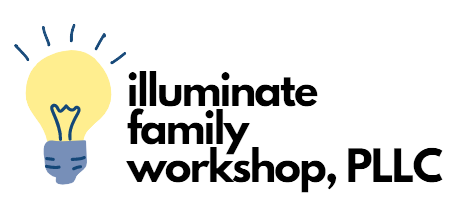Components of a Comprehensive
Speech & Language Evaluation
Illuminate Family Workshop, PLLC of Phoenix, Arizona, conducts evaluations are conducted to gather information about how an individual communicates, their strengths and identify any areas that need additional support. At the conclusion of the evaluation process, we’ll be able to answer these questions:
How does your child’s speech & language skills compare to same-aged peers?
How does your child learn best?
What are strategies to support them in becoming confident communicators?
What does your child’s support team need to know to promote and encourage progress?
Case History/Interview
Background information regarding medical history, developmental milestones will be collected via intake forms. The interview process will be guided by a series of topics: family values and goals, history of any current/prior intervention, relevant medical history, child’s interest and dislikes, speech and language concerns, sensory differences, and academic performance.
Observations
Observations at home and at school allows the SLP to collect data about a child’s communication skills in different environments. Observation data can allow the SLP to acknowledge how the communicative environment impacts their communication and learning skills.
Oral Mechanism Exam
An oral mechanism exam helps the clinician determine if the structure and function of the speech mechanisms is adequate for speech production. This involves inspecting the tongue, lisp, teeth, jaw, and palate.

Voice
Examining the client’s vocal quality can detect impairments in pitch, loudness, nasality, and hoarseness. If there are concerns, information may be collected on the impact impaired vocal quality has on daily life. Identifying the risk factors that may be causing the symptoms to worsen can be used to create a therapy program that is best suited to the child and their needs.
Fluency
Interview questions will collect information about presence and absence of stuttering, onset, environment, and impact of dysfluencies academically and socially. An analysis of speech fluency skills and stuttering-related behaviors determines if the client is experience stuttering or cluttering.
For younger children, this may look like collecting a speech sample through play and looking at pictures together. For older children, a speech sample and information from the client about their feelings and attitude toward speech will guide therapy recommendations.
Articulation
To detect speech sound errors, the client will name pictures containing target stimulus sounds at the word level, sentence level and conversational level. A speech sound inventory and analysis of the speech patters can be used to compare client’s productions to same-aged peers. The clinician will trial sound “stimulability.” This is the client’s ability to accurately imitate misarticulated sound when provide a series of cues. This can drive the selection of therapy target sounds.
Expressive and Receptive Language Assessment
The purpose of the language assessment is to determine how the client understands and uses language for a variety of purposes. This is accomplished through a language sample and a battery of assessments to compare their skills to same-aged peers. The tests are structured and unstructured situations using toys and materials to keep the client engaged. The analysis focuses on the following areas of language: semantics, syntax, morphology and phonology.
Pragmatics
Pragmatics refers to how language is used socially to achieve some purpose. This includes how communication is affected by different contexts and audiences and understanding of how messages are composed most effectively and an ability to determine the best use of different types of messages.
We are only a phone call away! Call 602-730-2977 and let us know how we can help with your child’s speech and language development.
Phone: 602-730-2977
Address: Phoenix, AZ, and surrounding areas
Monday - Friday: Hours Are by Appointment
Saturday - Sunday: Closed
Also Accept: FSA, HSA and ESA




